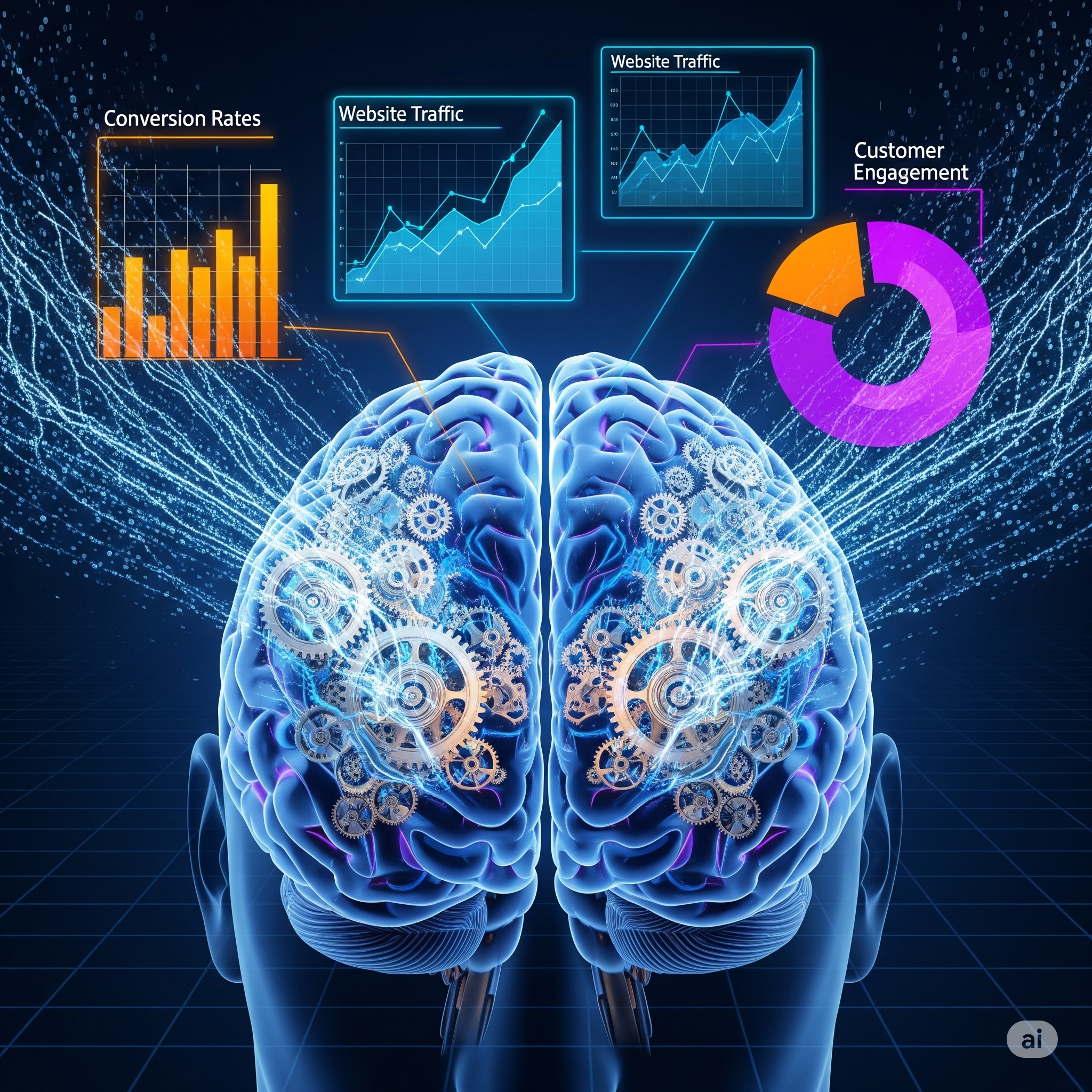In today’s fast-paced digital landscape, every marketing dollar counts. Businesses are under constant pressure to prove that their marketing efforts are not just creative and engaging, but also directly contributing to the bottom line. For decades, measuring this impact—known as return on investment (ROI)—has been a complex, and often imperfect, science. (marketing ROI with AI)
However, the game has completely changed. With the rise of artificial intelligence, marketers now have unprecedented power to optimize campaigns, personalize customer experiences, and, most importantly, accurately measure their marketing ROI with AI. This guide will demystify the process, showing you how to leverage AI to move beyond guesswork and achieve true marketing excellence. We’ll explore real-world applications, provide actionable tips, and recommend essential tools to help you get started. By the end, you’ll understand why AI is no longer a futuristic luxury but a foundational element for any successful marketing strategy.
What is marketing ROI with AI?
Before we dive into the “how,” let’s clarify the “what.” At its core, marketing ROI is a simple calculation: (Revenue from marketing – Marketing cost) / Marketing cost. This formula gives you a tangible number to prove the value of your campaigns. When we introduce AI into the equation, we’re talking about using intelligent systems to make every step of this process more efficient and effective.
AI’s role in boosting marketing ROI with AI is multifaceted. It’s not just about one single task; it’s about a complete transformation of the marketing workflow. For example, AI can analyze vast datasets in seconds, providing insights that would take a human team weeks to uncover. It can automate repetitive tasks, freeing up marketers to focus on strategy and creativity. Ultimately, AI elevates marketing from a series of educated guesses to a data-driven, precise discipline, ensuring every investment yields a higher return.
How to Measure and Improve Your marketing ROI with AI
Measuring marketing performance with AI isn’t a one-time activity. Instead, it’s a continuous loop of data collection, analysis, and optimization. First, you need to establish a baseline. What are your current key performance indicators (KPIs) and how are your campaigns performing now? Without this starting point, it’s impossible to tell if your AI implementation is making a difference. Second, you must identify the right metrics to track. The standard ROI formula is a great start, but AI marketing analytics can help you go much deeper.
Instead of just looking at the final revenue number, AI can help you analyze a variety of micro-metrics that contribute to it, such as customer lifetime value (CLV), cost per acquisition (CPA), and churn rate. By leveraging AI to track these granular details, you get a much clearer picture of what’s working and what’s not. From there, you can use AI to optimize your campaigns in real-time, making smarter decisions about where to allocate your budget and resources. This continuous feedback loop is the true power of measuring marketing ROI with AI.
Real-World Case Studies of Marketing ROI with AI
To truly understand the impact of artificial intelligence on marketing performance, it helps to look at real-world examples. Companies are already seeing significant gains by integrating AI into their marketing strategies. These aren’t just one-off experiments, but proven models for success.
Case Study 1: Netflix and Hyper-Personalization
Netflix is a master of personalization, and its AI-driven recommendation engine is a prime example of how to achieve massive marketing ROI with AI. The company’s algorithm analyzes a user’s viewing history, search queries, ratings, and even the time of day they watch to suggest content they are highly likely to enjoy. This isn’t just a simple “if you liked this, you’ll like that” approach. The AI is constantly learning and adapting, personalizing everything from the homepage layout to the thumbnail images for each show.
The measurable outcome? Netflix’s recommendation engine is responsible for over 80% of the content viewed on the platform. This hyper-personalization has drastically increased user engagement, reduced churn rates, and solidified customer loyalty. The ROI is evident not just in subscriber retention, but also in the time and resources saved by not having to manually promote content to a general audience. The AI does the heavy lifting, delivering a deeply personal experience that keeps users coming back for more.
Case Study 2: Heinz and Generative AI for Brand Engagement
In a more creative application of AI, Heinz successfully leveraged a text-to-image generator, DALL-E, for a groundbreaking campaign. The company simply prompted the AI to draw “ketchup” and used the resulting images—which all unmistakably resembled the iconic Heinz bottle—to prove that their brand is synonymous with the product itself.
The campaign generated a significant amount of media buzz and had a measurable impact on brand engagement. On social media, the campaign saw a 38% higher engagement rate compared to previous efforts. This example shows that marketing ROI with AI isn’t always about a direct sales increase. Sometimes, the return is in the form of enhanced brand visibility, increased customer interaction, and a powerful brand message. It demonstrates how AI can be a tool for creative brainstorming and unique campaign execution, providing a return that is both quantitative and qualitative.
The Role of AI Marketing Analytics in Boosting ROI
The foundation of successful marketing ROI with AI is robust analytics. AI marketing analytics moves beyond simple dashboards and reports, providing predictive and prescriptive insights that tell you what’s going to happen and what you should do about it. Instead of just summarizing past performance, AI can forecast future trends, predict customer behavior, and identify hidden patterns in your data.
This is a huge step forward from traditional analytics. For instance, an AI can process data from your CRM, social media, and website simultaneously to identify a specific audience segment that is most likely to convert in the next 30 days. Armed with this information, you can create a targeted campaign specifically for them, leading to a much higher conversion rate and a better return on your investment. Measuring AI marketing becomes a proactive, not reactive, process.
Key areas where AI marketing analytics supercharge ROI:
- Predictive Analytics: Forecasting sales, predicting customer churn, and identifying high-value leads.
- Customer Segmentation: Creating hyper-specific audience segments based on behavior, preferences, and demographics.
- A/B Testing Optimization: Running thousands of variations of a single ad or email to find the most effective one in a fraction of the time.
- Attribution Modeling: Accurately crediting which touchpoints and campaigns contributed to a sale, even in complex customer journeys.
Essential AI Tools to Improve Your Marketing Performance
Adopting AI doesn’t require a team of data scientists. There are many user-friendly tools available today that can help you improve your marketing ROI with AI. Here are a few recommendations:
- ChatGPT: A powerful large language model from OpenAI, perfect for brainstorming content ideas, drafting social media posts, and generating ad copy. It helps marketers increase output and streamline their content creation workflows.
- Midjourney: An AI image generator that can create stunning visuals from simple text prompts. Marketers can use it to quickly produce unique, on-brand imagery for blogs, ads, and social media without relying on stock photos.
- Tableau: While not a pure AI tool, Tableau leverages AI and machine learning to make data visualization and analysis more accessible. It can help you create interactive dashboards that quickly surface insights from your AI marketing analytics.
- HubSpot’s AI Tools: HubSpot has integrated AI capabilities directly into its platform, offering features like AI-powered content creation, predictive lead scoring, and automated SEO recommendations. This makes it a great all-in-one solution for improving marketing ROI with AI and other marketing tasks. You can learn more about their offerings at the HubSpot Blog.
A Simple Workflow for Adopting AI for a Better Marketing ROI
Ready to start? Here’s a beginner-friendly, three-step workflow to help you implement AI and start seeing results. This approach focuses on a small, manageable project to build your skills and confidence before scaling up.
Step 1: Automate Content Creation for Efficiency
Start by using an AI writing tool like ChatGPT to generate multiple variations of a piece of content, such as a social media post or an email subject line. The goal here is to save time and explore creative options you might not have considered. Instead of spending hours on a single piece of copy, you can get dozens of options in minutes. This immediate boost in productivity is a simple way to improve marketing ROI with AI.
Step 2: Optimize Ad Targeting with Data
Next, use your platform’s built-in AI capabilities. Most major advertising platforms, like Google Ads and Meta Ads, have advanced AI-powered “Smart Bidding” or “Advantage+” features. These algorithms analyze vast amounts of user data to automatically adjust bids and show your ads to the most relevant audiences in real-time. This can dramatically lower your cost per acquisition (CPA) and improve your overall return on ad spend. It’s a prime example of measuring AI marketing success through improved efficiency and better targeting.
Step 3: Analyze Performance and Iterate Finally
, use a tool like Tableau or the analytics in your marketing platform to monitor the performance of your AI-driven campaigns. Look for patterns in the data that the AI is generating. Is a certain ad variation performing exceptionally well? Is the AI consistently finding a new audience segment? Use these insights to refine your strategy for the next campaign. The key is to treat AI as a collaborator, not just a tool. Over time, this iterative process will continuously improve your marketing ROI with AI and drive better results.
The Future is Now: Why You Can’t Afford to Wait
The integration of AI into marketing is no longer a trend; it’s a fundamental shift. According to a report by McKinsey, over 75% of companies are already using AI in at least one business function. Those who are proactive in adopting AI are already seeing a significant competitive advantage. The longer you wait, the more ground you risk losing to competitors who are already using AI to personalize experiences, optimize their spending, and drive a better marketing ROI with AI.
AI Public Policy: The Secret to Smarter Government?
AI Unlocks Scientific Secrets Faster Than Ever. Here’s the Proof.
The good news is that starting is easier than ever. The tools are more accessible, the data is more abundant, and the workflows are becoming more intuitive. Remember, the goal isn’t to replace human marketers but to augment them, freeing them from mundane tasks and empowering them to be more strategic and creative. By embracing AI, you’re not just investing in technology; you’re investing in a smarter, more efficient, and more profitable future for your marketing efforts. The return on investment is waiting for you.
Your Competitors Are Building an AI Innovation Culture. Are You?
Keyword List: marketing ROI with AI, AI marketing analytics, measuring AI marketing, marketing ROI, artificial intelligence, marketing performance, AI tools, data analytics, customer experience, personalization, automation, digital marketing, return on investment



